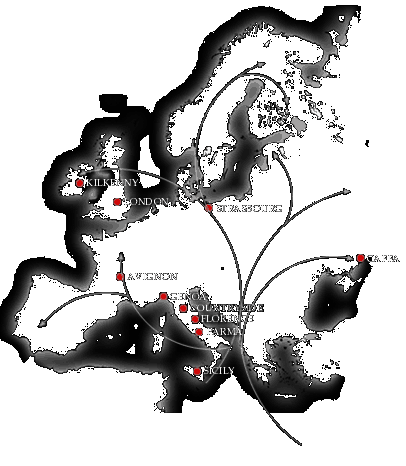

The Plague seems to have had its origins in Southeast Asia. It spread to China when the Mongol overlords of the Celestial Empire attempted to invade Southeast Asia. The Mongols carried the plague into Central Asia and southern Russia. It was there, whilst putting in to a Crimean port occupied by the Mongols, that the Genoese seem to have acquired the disease when the Mongols thoughtfully tossed the bodies of several of their plague victims over the walls using siege engines. This is the first known occurrence of biological warfare.
In October 1347, Genoese trading ships put into the harbor of Messina in Sicily with dead and dying passengers and crew. Several days past before the people of Messina realized what the ship had brought into their city, but the damage was already done. The ships and their crew were sent back out to sea only to spread the plague to other coastal cites. Port cities that were initially affected were Corsica, Sardinia, Barcelona and Valencia. From here, the plague spread like wild fire.

The urban centers of Europe were ripe for the epidemic and European cities were hardest hit. The death list mounted so fast in some places that the victims died unattended and the living could barely keep up with the grim task of burying the corpses. The pattern of the disease was similar for each city. When a city was stricken the disease usually remained active for about four to six months during which time it killed off a large segment of the population and disorganized the entire fabric of life. The disease was spread across land as well as across water. Even England was eventually reached by the plague via another trading ship. Ships that carried the coveted goods of the fabled east now also carried death.
The best estimates of modern demographers are that one third to a half of Europeans living in the warm air of the summer of 1347 would die by the winter of 1349 from the plague. Several major cities were hit extremely hard. These cities included Paris, Florence, Venice, and Hamburg. As much as 80% of the population was killed in these densely populated cities. There were many flourishing cities such as Rouen and Montpellier that never recovered from this gigantic loss.
The situation was almost as bad in the countryside. Peasants dropped dead on the roads, in the fields, and in their houses. Survivors, in growing helplessness, fell into apathy, leaving ripe wheat uncut and livestock untended. English sheep, bearers of the precious wool, caught the disease too, and died throughout the countryside, with reports of 5,000 dead in one field alone, the stench of their rotting carcasses filled the air for miles around.
Those who were wealthy enough fled from the cities to enjoy life to its fullest while they still could. Promiscuity and drunkenness abounded. This can be seen in Bocaccio's Decameron which tells the story of seven people who fled to the countryside to indulge in unthinkable acts. Needless to say, plague caught up with them.
The plague spared no one. Doctors and clergy were among those who were hardest hit as they attempted to care for the dying. The Pope survived though, much in part to the three gigantic bonfires which burned constantly around him. The intense heat obviously made it uncomfortable for the fleas, not to mention the Pope-- but he survived.
The Plague returned periodically, striking mostly children, until it disappeared from Europe in 1399, not to return again until the 17th century. The history of the plague is a graphic example of how a disease can spread rapidly across amazing distances at an alarming rate.